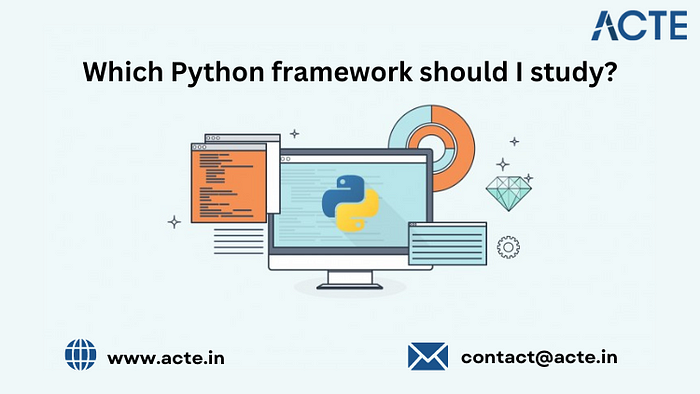In-Depth Guide to Selecting the Optimum Python Framework
The Python programming language has seen a remarkable surge in popularity in recent years, largely attributed to its versatility and wide applicability across various domains. A significant driver behind this widespread adoption is the abundance of frameworks available, streamlining tasks across domains such as web development, data analysis, and machine learning. However, with numerous options at hand, aspiring developers often encounter challenges in selecting the most suitable Python framework for their specific needs. For a comprehensive understanding of the diverse array of Python frameworks, considering enrollment in a Python Course in Hyderabad is advisable. These courses cover essential tools like Pandas, NumPy, Matplotlib, and Scikit-learn, imparting indispensable skills for data analysis, machine learning, and web development. This guide embarks on an exploration of popular Python frameworks and their respective domains to facilitate informed decision-making.

Understanding the Landscape:
Before diving into the specifics of Python frameworks, it's crucial to grasp the multifaceted landscape of Python development. Python frameworks serve as repositories of pre-written code and libraries, providing developers with a structured approach to application development and problem-solving. By offering tools, utilities, and conventions, these frameworks streamline development processes, enabling developers to produce cleaner, more maintainable code.
Factors to Consider:
Selecting a Python framework involves considering several factors, including personal interests, career aspirations, and the intended application domain. A meticulous assessment of individual needs and requirements is paramount to selecting a framework aligned with one's objectives. Furthermore, factors such as community support, documentation quality, and ease of learning significantly influence the overall developer experience with a framework.
Exploring Popular Python Frameworks:
Let's delve into some of the most widely utilized Python frameworks and their respective domains:
Pandas:
Pandas serves as a robust library for data manipulation, analysis, and cleaning within data science and analytics projects. Offering data structures and functions for efficient handling of large datasets, Pandas facilitates operations like filtering, grouping, and aggregation.
NumPy:
NumPy is an indispensable tool for numerical computing, array manipulation, and mathematical operations in Python. With high-performance multidimensional arrays and an extensive collection of mathematical functions, NumPy finds application in scientific computing and machine learning endeavors.
Matplotlib and Seaborn:
Matplotlib and Seaborn are popular choices for data visualization in Python. These libraries empower developers to create a diverse range of plots, charts, and graphs, effectively communicating insights derived from data. While Matplotlib offers extensive customization options, Seaborn provides a higher-level interface for crafting visually appealing statistical visualizations.
Scikit-learn:
Scikit-learn stands out as a versatile library for machine learning tasks in Python. Offering a wide array of algorithms and tools for classification, regression, clustering, and model evaluation, Scikit-learn caters to both novice and experienced machine learning practitioners.
TensorFlow and PyTorch:
TensorFlow and PyTorch are leading frameworks for deep learning and neural network development. Equipped with high-level APIs and tools, these frameworks facilitate the building, training, and deployment of complex models across diverse applications such as image recognition and natural language processing.
Django and Flask:
Django and Flask emerge as prominent web frameworks for constructing web applications, APIs, and backend services in Python. While Django offers a comprehensive feature set following the "batteries-included" philosophy, Flask distinguishes itself with its lightweight and flexible nature, allowing developers to tailor their components as needed. To deepen your understanding of Python frameworks and their applications in data science, machine learning, and web development, consider enrolling in a Python Course Online.

Keras:
Keras serves as a high-level deep learning API atop TensorFlow, facilitating rapid prototyping and experimentation with neural networks. With its user-friendly interface, Keras is ideal for developing and refining deep learning models.
Beautiful Soup and Scrapy:
Beautiful Soup and Scrapy prove invaluable for web scraping and crawling tasks in Python. These libraries enable developers to extract data from websites and web pages, facilitating data collection and aggregation for further analysis.
Choosing the Right Framework:
When selecting a Python framework, it's essential to consider one's specific interests and career trajectory within the realm of Python development. Whether the focus lies in data science, machine learning, web development, or any other domain, there exists a framework tailored to individual needs. Furthermore, exploring tutorials, documentation, and community support for each framework can offer valuable insights into usability and suitability for various projects.
Conclusion:
In summary, the choice of a Python framework hinges on a multitude of factors, including personal interests, career goals, and the intended application domain. By navigating the diverse landscape of Python frameworks and understanding their respective domains, developers can make informed decisions aligned with their objectives. Whether embarking on data analysis, machine learning, web development, or other Python-based endeavors, the availability of frameworks ensures that there's a tool perfectly suited to bring ideas to fruition.